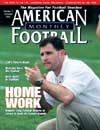AMERICAN FOOTBALL MONTHLY THE #1 RESOURCE FOR FOOTBALL COACHES
Article CategoriesAFM Magazine
|
The Universal Route That Is Good Versus Any Coverageby: Jimbo FisherOffensive Coordinator, LSU © More from this issue In today's World of multiple defenses, getting the right play called at the proper time is becoming harder and harder. The answer to this problem has come down to a couple of potential solutions. One is the audible, which everybody uses. The problem with this is that a defense can audible when you audible, or they can simply change their defensive coverage on the snap of the ball. The other answer is to call universal routes that can adapt to any coverage with a few basic and simple reads. One of these routes is the smash route. The smash route is basically a two-man route. It consists of the outside offensive player running a 5-to 6-yard hitch route and the inside offensive player running an eight step or 12 yard smash route. We call this a smash route because the route, will be read at the break point. (See Diagram....The full article can only be seen by subscribers.
|
|
|||||||
| HOME |
MAGAZINE |
SUBSCRIBE | ONLINE COLUMNISTS | COACHING VIDEOS |
Copyright 2025, AmericanFootballMonthly.com
All Rights Reserved





